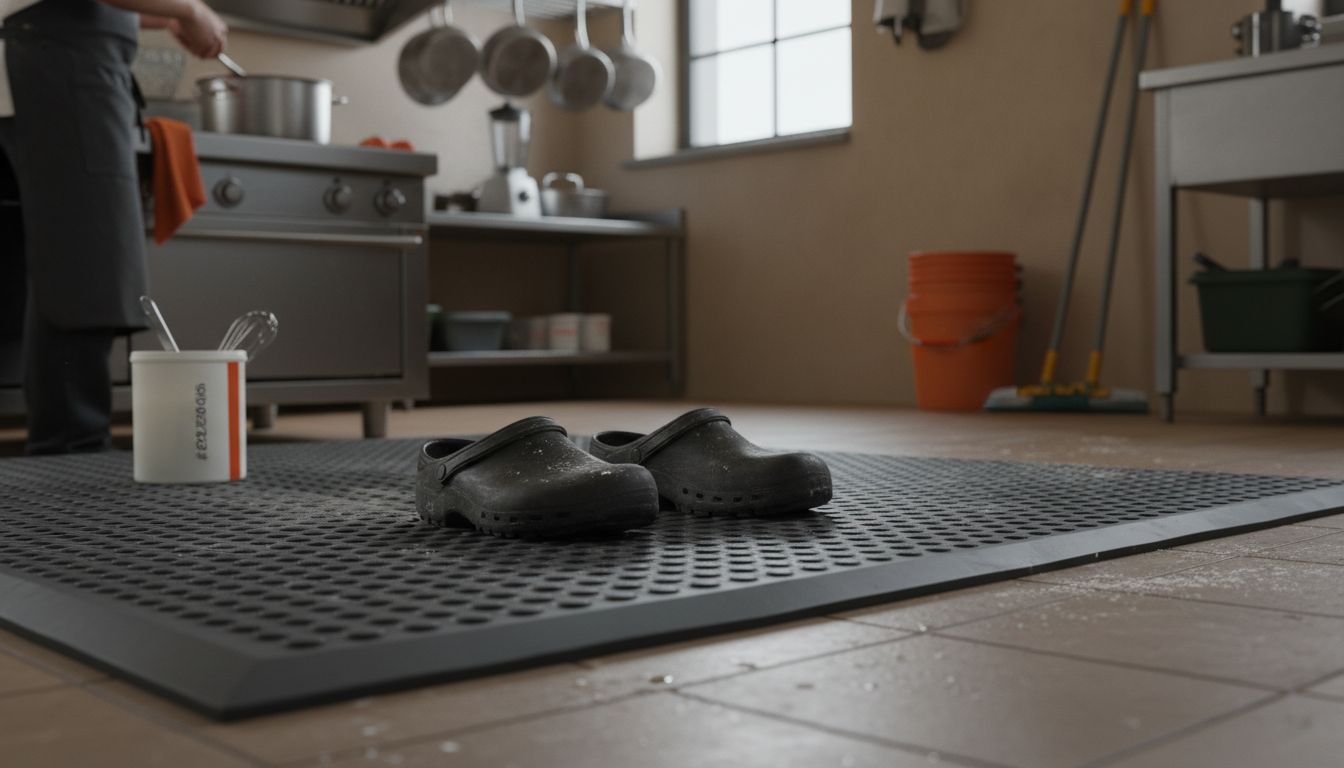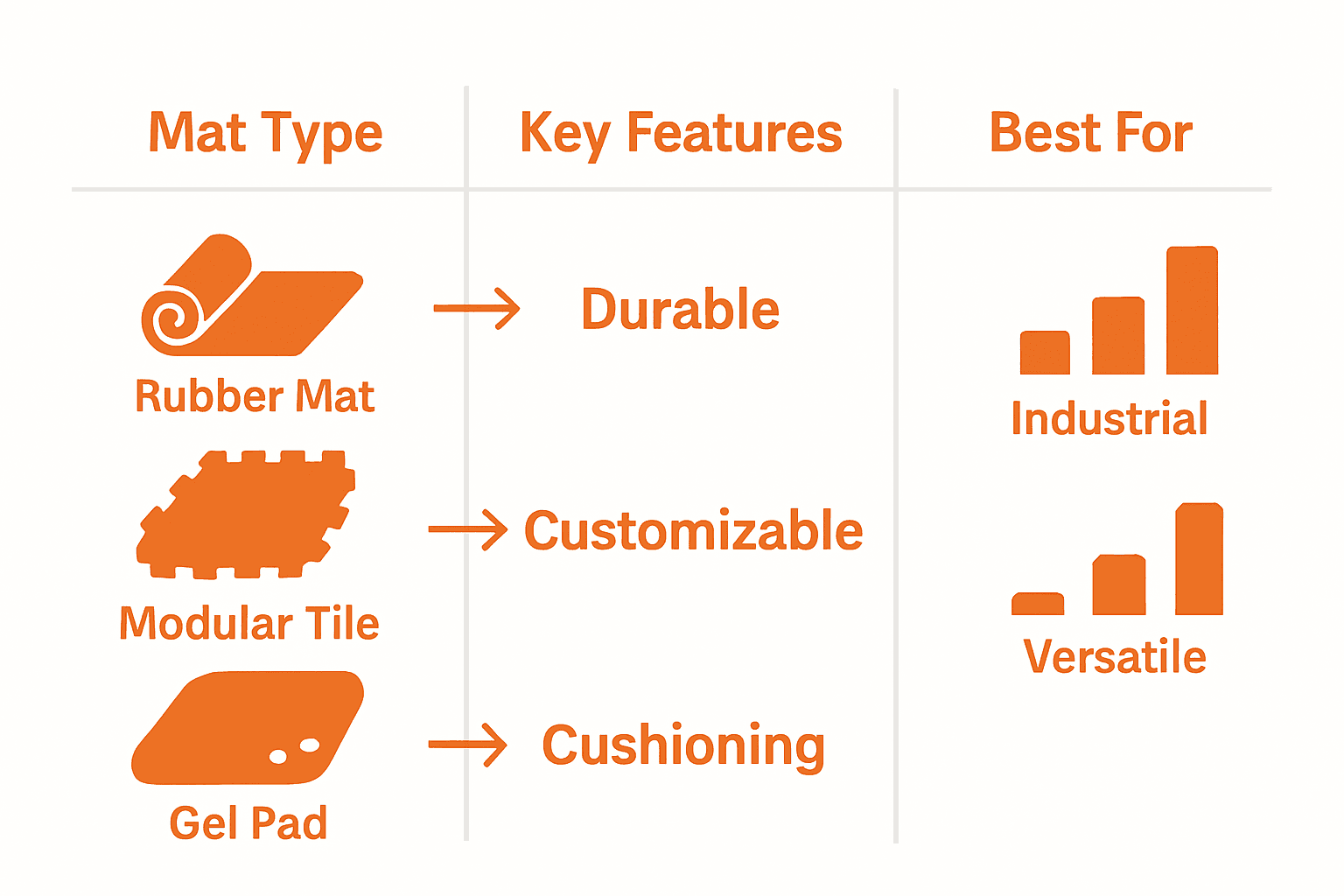Standing for hours on a hard kitchen floor can lead to serious health issues, with studies showing that over 70 percent of kitchen staff report persistent aches and fatigue. Whether in a bustling restaurant or a home kitchen, this discomfort doesn’t just hurt your back—it can affect productivity and mood. The right anti fatigue mats offer targeted support, reduce daily strain, and play a vital role in creating safer, healthier workspaces for anyone who spends long periods on their feet.
Table of Contents
- Defining Anti Fatigue Mats For Kitchen Use
- Types Of Kitchen Anti Fatigue Mats Explained
- Key Features And Ergonomic Benefits
- Choosing The Right Mat For Commercial Kitchens
- Cost, Maintenance, And Safety Considerations
Key Takeaways
| Point | Details |
|---|---|
| Ergonomic Design | Anti fatigue mats enhance worker comfort and productivity by reducing strain from prolonged standing in kitchen environments. |
| Material and Features | Choosing mats with appropriate materials, cushioning, and slip resistance is crucial for safety and efficiency in commercial kitchens. |
| Strategic Placement | Proper mat placement can significantly reduce fatigue and the risk of musculoskeletal disorders among kitchen staff. |
| Investment in Quality | Prioritizing durable, high-quality mats over cheaper alternatives ensures long-term safety, compliance, and cost-effectiveness in maintenance. |
Defining Anti Fatigue Mats for Kitchen Use
Anti fatigue mats are specialised floor coverings designed to reduce physical strain and discomfort for workers who stand for prolonged periods in kitchen environments. These ergonomic solutions provide critical support for professionals who spend hours preparing meals, washing dishes, or managing culinary operations.
Typically constructed from durable materials like rubber, vinyl, or polyurethane, anti fatigue kitchen mats feature unique cushioning technologies that create micromovement in leg muscles. By encouraging subtle muscle contractions and blood circulation, these mats help prevent the physical stress associated with standing on hard surfaces. Anti-Fatigue Mats UK: The Ultimate Workplace Safety Guide highlights that strategic mat placement can significantly reduce workplace fatigue and potential musculoskeletal disorders.
Key characteristics of effective kitchen anti fatigue mats include:

- Slip-resistant surface design
- Comfortable cushioning thickness
- Chemical and heat resistance
- Easy to clean and maintain
- Adaptable to various kitchen floor conditions
Professional kitchens, home cooking spaces, and commercial culinary environments can all benefit from these ergonomic floor solutions. By prioritising worker comfort and safety, anti fatigue mats represent a critical investment in workplace wellbeing and productivity.
Types of Kitchen Anti Fatigue Mats Explained
Commercial kitchens require different types of anti fatigue mats to address specific workplace challenges, ranging from basic protection to advanced ergonomic solutions. Understanding these variations helps businesses select the most appropriate flooring support for their unique culinary environments.
Rubber Kitchen Mats are the most common and versatile anti fatigue solution, offering exceptional durability and resilience. These mats typically feature textured surfaces that provide slip resistance and drainage capabilities. The Ultimate Guide to Non-Slip Rubber Kitchen Mats for UK Commercial Environments highlights that rubber mats are particularly effective in areas prone to moisture and potential spills.
Different types of kitchen anti fatigue mats include:
Here’s a comparison of common kitchen anti fatigue mat types:
| Mat Type | Key Features | Best For |
|---|---|---|
| Rubber Cushion Mats | Dense cushioning Slip resistant |
High-traffic food prep zones |
| Modular Kitchen Mats | Interlocking Customisable coverage |
Odd-shaped or large areas |
| Chemical-Resistant Mats | Resists oils and chemicals | Food prep and dishwashing |
| Bevelled Edge Mats | Reduced trip hazards Easy cleaning |
Transitions between surfaces |
| Ergonomic Gel Mats | Advanced cushioning Enhances comfort |
Long stationary standing tasks |
- Rubber Cushion Mats: Dense, shock-absorbing surfaces ideal for high-traffic areas
- Modular Kitchen Mats: Interlocking designs allowing customisable coverage
- Chemical-Resistant Mats: Specifically engineered for food preparation zones
- Bevelled Edge Mats: Reducing trip hazards and providing smooth transitions
- Ergonomic Gel Mats: Advanced cushioning for extended standing periods
Professional kitchens can strategically combine these mat types to create comprehensive floor protection solutions that enhance worker comfort, safety, and productivity.
Key Features and Ergonomic Benefits
Anti fatigue mats represent a sophisticated ergonomic solution designed to mitigate the physical challenges of prolonged standing in kitchen environments. By integrating advanced material science and biomechanical principles, these mats transform workplace comfort and reduce potential health risks associated with extended periods of standing.
Maximising Productivity and Well-being: A Comprehensive UK Guide to Anti Fatigue Mats emphasises that strategic mat selection can dramatically improve workplace ergonomics. The key ergonomic benefits include:
- Muscle Activation: Encouraging micro-movements that prevent muscle stiffness
- Circulation Enhancement: Reducing blood pooling in lower extremities
- Shock Absorption: Minimising joint stress from hard kitchen floors
- Posture Support: Promoting natural spinal alignment during extended standing
- Fatigue Reduction: Decreasing overall physical strain and potential musculoskeletal disorders
The sophisticated design of modern anti fatigue mats goes beyond simple cushioning. These engineered surfaces create a dynamic interaction between the worker’s body and the floor, transforming potentially harmful standing environments into zones of comfort and productivity. By prioritising worker well-being, businesses can simultaneously enhance employee health and operational efficiency.
Choosing the Right Mat for Commercial Kitchens
Selecting the appropriate anti fatigue mat for a commercial kitchen requires careful consideration of multiple critical factors. The right mat can significantly impact workplace safety, employee comfort, and overall operational efficiency.
The Penny-Wise, Pound-Foolish Truth About Cheap Floor Mats emphasises that investing in quality matting is crucial for long-term workplace performance. When choosing a kitchen anti fatigue mat, businesses should evaluate several key selection criteria:
- Material Durability: Resistance to oils, chemicals, and frequent cleaning
- Thickness and Cushioning: Appropriate level of shock absorption
- Surface Texture: Optimal slip resistance for wet environments
- Size and Coverage: Matching specific workplace layout requirements
- Drainage Capabilities: Efficient liquid dispersal in high-moisture areas
Professional kitchens must also consider specific zone requirements. Front-of-kitchen preparation areas might need different matting compared to dishwashing stations or high-traffic cooking zones. Strategic mat selection involves understanding each workspace’s unique environmental challenges and selecting tailored solutions that enhance both safety and productivity.

Cost, Maintenance, and Safety Considerations
Navigating the complex landscape of anti fatigue mat investment requires a holistic approach that balances initial costs, long-term durability, and workplace safety standards. Commercial kitchens must view these mats not as an expense, but as a critical investment in employee well-being and operational efficiency.
Master Commercial Mat Cleaning for Pristine Results highlights the importance of strategic maintenance in extending mat lifecycle and preserving workplace hygiene. Key considerations for cost-effective and safe mat management include:
- Initial Investment: Prioritising quality over short-term savings
- Cleaning Frequency: Regular maintenance to prevent slip hazards
- Material Replacement Cycles: Understanding expected lifespan of different mat types
- Workplace Safety Compliance: Meeting industry-specific health and safety regulations
- Hidden Cost Reduction: Preventing potential workplace injury expenses
Professional kitchens must adopt a proactive approach to mat management. This means not just selecting the right mat, but implementing robust cleaning protocols, conducting regular inspections, and replacing mats before they become potential safety risks. By viewing anti fatigue mats as a strategic asset rather than a mere floor covering, businesses can create safer, more efficient working environments.
Enhance Kitchen Comfort with Expert Anti Fatigue Mat Solutions
Standing long hours in the kitchen can cause intense fatigue and discomfort that affects both well-being and productivity. The article highlights crucial challenges such as muscle strain, fatigue reduction, and slip resistance that every commercial kitchen must tackle. Choosing the right anti fatigue mats with durable materials and superior cushioning is essential for creating a safer and more comfortable workspace.
At Mats4U, we understand these demands and offer a wide range of bespoke mat solutions tailored for busy environments. Discover our collection of Home Mats | Cloakroom Mats | Speciality Mats which includes robust rubber and chemical-resistant mats ideal for kitchens requiring both comfort and safety. Our mats feature slip-resistant surfaces and long-lasting cushioning to support your team through their longest shifts.

Don’t let tired feet slow down your kitchen operations. Explore our customised anti fatigue mats today and transform your workplace comfort while meeting strict safety standards. Visit Mats4U now to find the perfect mat solution that will help protect your staff and enhance productivity from the ground up.
Frequently Asked Questions
What are anti fatigue mats for kitchens?
Anti fatigue mats are specialized floor coverings designed to reduce physical strain and discomfort for individuals who stand for long periods in kitchen environments, providing support to improve comfort and safety.
What materials are commonly used to make kitchen anti fatigue mats?
Kitchen anti fatigue mats are typically constructed from durable materials such as rubber, vinyl, or polyurethane, featuring unique cushioning technologies to enhance ergonomic support.
How do anti fatigue mats benefit employees in professional kitchens?
Anti fatigue mats encourage muscle activation, enhance circulation, absorb shock, support posture, and reduce fatigue, helping to mitigate health risks associated with prolonged standing.
What factors should I consider when choosing an anti fatigue mat for a commercial kitchen?
When selecting an anti fatigue mat, consider material durability, thickness and cushioning, surface texture, size and coverage, and drainage capabilities to ensure safety and comfort in your kitchen environment.
Recommended
- The Ultimate Guide to Non-Slip Rubber Kitchen Mats for UK Commercial E – Mats4U
- Shattering the Silence: How Strategic Matting Prevents Costly Glass Br – Mats4U
- Anti-Fatigue Mats UK: The Ultimate Workplace Safety Guide – Mats4U
- How to Effectively Manage Wet & Slippery Surfaces in the UK Food I – Mats4U









